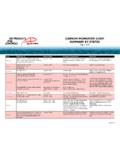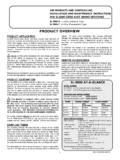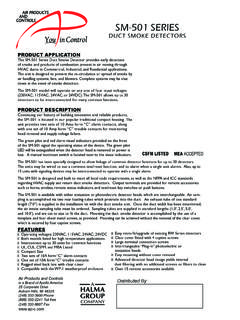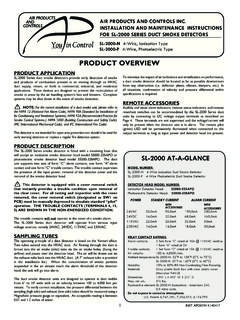Transcription of SL-701 DUCT CARBON MONOXIDE DETECTOR KIT …
1 Tech Support # 1-888-332-2241 INST SL-701 110124 or 1-248-332-3900 1 To get FPM from CFM: CFM / ( duct W x duct H ) SL- 701 duct carbon monoxide detector kit INSTALLATION AND MAINTENANCE INSTRUCTIONS PRODUCT OVERVIEW CONTENTS SL-701 duct CARBON MONOXIDE DETECTOR MSR-50/CO Remote Accessory FAST Sample Tube Assembly Kit 8 FAST Exhaust Tube Mounting Template and Screws SL-701 SPECIFICATIONS Input Power Standby Current Alarm Current 24 VAC 43 mA 246 mA 24 VDC 28 mA 187 mA 115 VAC 23 mA 50 mA 230 VAC 11 mA 28 mA Relay Contact Ratings: Alarm contacts: (2) Sets of form C rated 10A @ 115 VAC resistive (1) form A rated at 2A Trouble contacts: (1) Set of form C rated 10A @ 115 VAC resistive Air Velocity: 100 to 4000 feet per minute Ambient temperature: 32 F to 140 F (0 C to 60 C) Humidity: 10% to 85% RH Non-Condensing/Non-Freezing Dimensions: 13 L 4 W 2 D MSR-50/CO SPECIFICATIONS Current Draw Standby 0 mA Alarm 105 mA Audible Hi 69 db @ 10 Lo 54 db @ 10 Format ANSI Temporal 4 Continuous Visual 2 CD on axis 1 HZ (1/S) PRODUCT APPLICATION The SL- 701 duct carbon monoxide detector kit provides early detection of CARBON MONOXIDE in air moving through the HVAC duct supply, return, or both in commercial, industrial, or residential applications.
2 Complete HVAC systems can be shut down in the event of CARBON MONOXIDE detection. The included MSR-50CO remote accessory can be used to provide Private Mode (non-public) audible and visual alarm indication in a remote location. Combination CO / Fire alarm control units can, and must, be notified of an alarm or trouble condition to provide Public Mode Notification and Remote Reporting. NOTE: The SL-701 is intended to be connected to a fire alarm control unit or combination control unit if present. Please refer to NFPA 720 (Standard for the Installation of CARBON MONOXIDE (CO) Detection and Warning Equipment) and NFPA 72 (National Fire Alarm and Signaling Code). This is not a duct smoke DETECTOR (UL 268A) or CO alarm (UL 2034) and is not designed to detect smoke, fire or any gas other than CARBON MONOXIDE as caused by fossil fuel fired appliances and / or as introduced from the outside in fresh air intakes in the HVAC system.
3 The SL-701 is a CO system DETECTOR (UL 2075). PRODUCT DESCRIPTION The SL-701 duct mounted CARBON MONOXIDE DETECTOR is fitted with an electrochemical sensor that is able to detect four levels of CARBON MONOXIDE and has a life of approximately six years in normal environmental conditions. NOTE: Areas of high or low temperature and low humidity will reduce the life expectancy of the sensor. In all cases, an end of life trouble report will be signaled. The DETECTOR has two sets of form C alarm contacts, one set of form A alarm contacts, and one set of form C trouble contacts. The alarm INST SL-701 110124 2 contacts can be used to shut down HVAC equipment and signal a fire alarm control unit of an alarm condition.
4 The trouble contact supervises the presence of input power, removal of the DETECTOR cover, removal of the sensor, or a sensor end of life. SAMPLING TUBES The operating principle of a duct DETECTOR is based on the Venturi effect. Two tubes extend into the HVAC duct . Air flowing through the duct is forced through the sampling tube via the opening in the tube pointed toward the airflow. The airflow is passed over the sensor and is drawn out via the exhaust tube back into the duct . The duct CARBON MONOXIDE DETECTOR units are designed to operate in duct widths from 6 to 10 wide with an air velocity between 100 to 4000 feet per minute. To verify correct installation, the pressure differential between the sampling (high side) and exhaust (low side) tubes should be measured using a Magnehelic pressure gauge or equivalent.
5 An acceptable reading is between and inches of water. REMOTE ACCESSORY The SL-701 duct CO DETECTOR kit includes the MSR-50/CO remote accessory (non-supervised). This device is designed to provide Private Mode visual and audible indicators of DETECTOR status. The remote is wired to the SL-701 on the DC voltage terminals as shown on page 4. The remote will show a green LED in normal operation, and will change to a red LED in an alarm or test condition. The LED will be off during any trouble condition. The included sounder will give a temporal code 4 tone and the strobe will flash in an alarm or test condition. DANGERS OF CARBON MONOXIDE CARBON MONOXIDE (CO) is an odorless, tasteless and highly toxic gas that results from the incomplete combustion of fossil fuels.
6 It is often referred to as the silent killer because it is virtually impossible to detect without sensing technology. Through the normal living process of respiration and circulation, oxygen molecules enter the lungs and are transported to cells throughout the body by attaching to hemoglobin in the blood. CO molecules, however, attach to hemoglobin far more readily than oxygen. When CO is present in the environment, these molecules interfere with the normal circulation of oxygen throughout the body by attaching to hemoglobin that would normally transport oxygen. This can cause varying levels of injury, sickness and even death, depending on length and level of exposure. CO poisoning can result from prolonged exposure to low levels of CO and / or shorter exposures to higher concentrations as shown in the table below.
7 CO concentration in parts per million (PPM) Symptoms 50 No adverse effects with 8 hours of exposure 800 Headache, nausea, and dizziness after 45 minutes of exposure; collapse and unconsciousness after 2 hours of exposure 1000 Loss of consciousness after 1 hour of exposure 6400 Headache and dizziness after 1-2 minutes of exposure; unconsciousness and danger of death after 10-15 minutes of exposure ALARM LEVELS The electrochemical sensor in the SL-701 is programmed to monitor four levels of CARBON MONOXIDE . The status LED on the sensor will flash a red LED code depending on the level of CO sensed as shown below. CARBON MONOXIDE levels (PPM) (Applicable National Standard) Alarm response time (Time Weighted Average) Red Status LED code 50-70 parts per million (OSHA IAQ) For 8 hours 2 Flashes 70-150 parts per million (UL 2075 / 2034) For 2 hours 3 Flashes 150-400 part per million (UL 2075 / 2034) For 15 minutes 4 Flashes 400+ parts per million (UL 2075 / 2034) For 5 minutes 5 Flashes INST SL-701 110124 3 MECHANICAL INSTALLATION LOCATION PREREQUISITES To determine the correct installation position for an SL-701 Series duct CARBON MONOXIDE DETECTOR , the following factors must be considered.
8 A uniform non-turbulent (laminar) airflow between 100 to 4000 ft/min. The pressure differential between the sampling and exhaust tubes must be between and inches of water. On supply side duct the DETECTOR must be installed after the heat exchanger and before any duct branches. The DETECTOR can be mounted after fresh air intakes on the return duct to monitor possible CO contamination from outside sources. The DETECTOR must be installed in an area that is accessible for future testing and maintenance. SAMPLING TUBE ASSEMBLY The SL-701 duct CARBON MONOXIDE detectors employ a specially notched sampling tube.
9 The kit includes 3- 18 sampling tubes, 1- 8 exhaust tube, a notched sampling tube starter, and a red stopper cap. The sampling tube sections can be combined for a total length of 54 inches. The notched sampling tube starter must be connected to the first length of sampling tube for proper connection to DETECTOR housing. The sampling tube is a plastic tube with an opening running the length on one side. These tubes can be cut to fit and must span at least 80% of the duct width. Any tubes over 3 in length must be supported on the side of the duct opposite from the DETECTOR . To ensure correct operation of the sampling tube, the red stopper cap that is included with the kit must be installed at the end of the sampling tube.
10 NO-TOOLS TUBE INSTALLATION The SL-701 Series duct CARBON MONOXIDE DETECTOR provides a unique, patented mechanism for installation and/or removal of the sampling and exhaust tubes from either the front or rear of the DETECTOR housing. Once airflow direction has been determined, insert the sampling and exhaust tubes into the CO DETECTOR . If the cover is in place, the tubes may be inserted into the back of the DETECTOR via the key-slots provided. Simply push the tube into place against the spring loaded retainer, and turn into the correct position, allowing the key to lock the tube in the desired orientation. For front side installation, simply rotate the tube retainer until the tube may be inserted and oriented properly.






